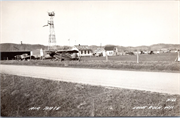Property Record
E2525 COUNTY HIGHWAY JJ
Architecture and History Inventory
| Historic Name: | Flight Service Station, Lone Rock Airport |
|---|---|
| Other Name: | Restaurant, Tri-County Regional Airport |
| Contributing: | |
| Reference Number: | 242138 |
| Location (Address): | E2525 COUNTY HIGHWAY JJ |
|---|---|
| County: | Sauk |
| City: | |
| Township/Village: | Spring Green |
| Unincorporated Community: | |
| Town: | 9 |
| Range: | 3 |
| Direction: | E |
| Section: | 31 |
| Quarter Section: | SW |
| Quarter/Quarter Section: |
| Year Built: | 1950 |
|---|---|
| Additions: | C. 1983 |
| Survey Date: | 2020 |
| Historic Use: | airport |
| Architectural Style: | Astylistic Utilitarian Building |
| Structural System: | |
| Wall Material: | Aluminum/Vinyl Siding |
| Architect: | |
| Other Buildings On Site: | Y |
| Demolished?: | No |
| Demolished Date: |
| National/State Register Listing Name: | Not listed |
|---|---|
| National Register Listing Date: | |
| State Register Listing Date: |
| Additional Information: | Lone Rock Airport was established in 1923. The “first serious use of aviation” in the county had begun in 1918 when the United States Post Office “inaugurated air mail service” to “improve mail delivery and reduce costs.” Over the next several years, “airports developed along Air Mail service routes until the fall of 1925.” That year, the Kelly Air Mail Act of 1925 “authorized the Post Office to contract with private operators to fly the mail. After 1927, the development of entirely new routes produced a boom period in airport construction” (Milbrooke 1998, 7). The first legislation to “regulate civil aeronautics” was the Air Commerce Act of 1926, which led to the development and standardization of the national air transportation system and installation of navigation aids at airports (ibid). Because of its location midway between Minneapolis and Chicago, in 1927 Lone Rock Airport was designated an emergency airmail landing field. The facility “was upgraded with a flashing white beacon, runway lighting, a weather station, and radio” (Midwest Flyer 2012). During World War II, the airport was a destination for naval training flights out of Chicago. After the war, the “facility was controlled by the Civil Aeronautics Administration (CAA) and a flight service station was established to provide weather reports and air traffic control for southwestern Wisconsin” (Hart 2020). In 1954, the CAA transferred control of the airport to the counties of Richland, Sauk, and Iowa, and it was renamed the Tri-County Regional Airport. The airport continued as a flight service station until 1983, at which time its building was remodeled and converted into a restaurant. The Tri-County Regional Airport, classified as a medium general aviation airport. Lone Rock Airport was established in 1923. It was “upgraded with a flashing white beacon, runway lighting, a weather station, and radio” in 1927; that year, the airport was designated an emergency airmail landing field (Midwest Flyer 2012). During World War II, the airport was a destination for naval training flights out of Chicago. After the war, the “facility was controlled by the Civil Aeronautics Administration (CAA) and a flight service station was established to provide weather reports and air traffic control for southwestern Wisconsin” (Hart 2020). In 1954, the CAA transferred control of the airport to the counties of Richland, Sauk, and Iowa, and it was renamed the Tri-County Regional Airport. The airport continued as a flight service station until 1983, at which time its building was remodeled and converted into a restaurant. As of this survey, the airport covered about 225 acres (Exhibit 2, 3). The oldest buildings (built ca. 1945 to 1980) on the property are clustered at the northwest corner near the intersection of County Highway JJ and County Line Drive. The two oldest buildings, a flight service station and barrel-roof garage were constructed ca. 1945-50. The station ceased operations in 1983, at which time the small, one-story side-gable frame structure was remodeled and repurposed to become a restaurant; it presently operates as the Picadilly Lilly Airport Diner (ATC History 2017). Photographs indicate the east half of the building was added after 1954, and the gabled entry bay and access ramps were added after its conversion to a restaurant (LL Cook Co. 1951, WHS 1954). It has replacement vinyl lap siding and modern sash windows (two windows are boarded over). The building suffered significant flood damage in fall 2019 and summer 2020 (Adams 2020). The building no longer functions in its historic capacity. Set in the far northwest corner, the barrel-roof garage is a pole building and was historically used as a hangar. It retains its form and alterations have been in keeping with its historic appearance. The metal siding in the gable-end is worn and weathered, but the roof and sidewalls have been re-clad with modern metal sheeting. The front doors have been replaced or refaced; portions of the historic wood doors are intact but in poor condition. Two buildings were constructed between 1954 and 1980. A utilitarian 3-bay metal garage is set between the historic hangar and flight service station. The side-gable office/terminal building stands east of the restaurant, and has several additions. The oldest section on the west end is a one-story structure with vertical wood cladding and a faux-brick base. Its asymmetrical façade has a central doorway, and four bays with casement windows. Two metal-clad pole buildings additions were added sometime before 1992. They project from the east elevation and are larger in scale than the original section. The building suffered flood damage in fall 2019, which “destroyed the carpet, installation, and drywall” (Saha 2019). Nineteen hangars were built after 1980. They are all utilitarian metal-clad pole buildings. A 300’-long narrow gabled pole building is set south of the historic buildings and primary plane parking area. It was built between 1980 and 1986. To its south, there are three small gabled hangers; one was built between 1986 and 1992, and two were built ca. 2008. A row of five hangars of varying sizes stand near the north end of the taxiway. The long, narrow building was built before 1992, and the rest were built before 2006. Ten small hangars stand at the south end of the property. Four predate 1980; one was built before 1992, three after 1992, and two after 2006. Most hangars also suffered flood damage in 2019 (Alfini 2019). There are two asphalt runways; one is 5,000 feet long and runs east, parallel to CH JJ; the second is 1,850 feet long and runs south to Mercer Road (WisDOT 2011, 103). Although the layout of the runways is historic, they have been lengthened, widened, and are continually improved. Similarly, historic weather and radar equipment and runway lighting and beacons have been upgraded. There are also parking areas for planes and automobiles in the northwest corner and a taxiway that runs southwest and south to hangars. The Tri-County Airport holds associations to events and patterns important to the history of aviation in America. Its initial construction was likely associated with the United States Post Office, which “inaugurated air mail service in 1918,” which spurred airport development along air mail routes across the country. In 1927, the airport was established as an emergency airmail landing field. That year, because of the Commerce Act of 1926, the airport was improved with modern weather, lighting, and radio equipment. After World War II, a flight service station was established to provide weather reports and air traffic control for the region. It continued to operate until 1983. Airport ownership was transferred to Sauk, Richland, and Iowa Counties in 1954, and it has since operated as a regional public use airport. No pre-World War II buildings or structures survive, and the flight service station building has been significantly altered. There are no extant buildings from 1923 to ca. 1945, and only two buildings from ca. 1945-50 survive. Sometime after 1954 the flight service station was enlarged, and was later converted to a restaurant in 1983. Although the layout of the runways is historic, they have been lengthened, widened, and continually improved. |
|---|---|
| Bibliographic References: | Air Traffic Control History (ATC History). 2017 “Lone Rock FSS Building.” Available online, http://www.atchistory.org/lone-rock-fss/. Accessed September 6, 2020. Alfini, Michelle. 2019 “Tri-County Regional Airport faces flooding for second time this year.” WKOW, September 30. Available online, https://wkow.com/2019/09/30/tri-county-regional-airport-faces-flooding-for-second-time-this-year/. Accessed September 4, 2020. Apps, Jerry. 2019 “How Technological Innovations Reshaped Rural Life,” Wisconsin Agriculture: A History. Madison: Wisconsin Historical Society Press. Excerpt available via WisContext, https://www.wiscontext.org/midcentury-revolution-farming-would-change-wisconsin-forever. Accessed September 8, 2020. Cole, Harry Elsworth. 1918 A Standard History of Sauk County, Wisconsin. Chicago: Lewis Publishing Co. Available online, https://archive.org/details/bub_gb_PV40AQAAMAAJ/mode/2up. Accessed September 4, 2020. Cook, L.L. Company. 1951 “Air Base, Lone Rock, Wis.” postcard. Milwaukee: L.L. Cook Co. Available online, https://thegayraj.com/air-base-lone-rock-wis/. Accessed September 8, 2020. Google. 1992-2013 Aerial Photographs. Google Earth online mapping application. Available online, https://www.google.com/earth/. Accessed September 4, 2020. Midwest Flyer Magazine. 2012 “Lone Rock – Where a VOR & Airport Restaurant Live On!” Midwest Flyer Magazine. Available online, https://midwestflyer.com/?p=4624. Accessed September 4, 2020. Milbrooke, Anne, et al. 1998 Guidelines for Evaluating and Documenting Historic Aviation Properties (National Register Bulletin 43). U.S. Department of the Interior, National Park Service, National Register of Historic Places. Available online, https://www.nps.gov/subjects/nationalregister/upload/NRB43-Complete.pdf. Accessed September 6, 2020. Saha, Victoria. 2019 “Thaw helps Tri-County Regional Airport recover.” WAOW.com, November 16. Available online, https://waow.com/2019/11/16/thaw-helps-tri-county-regional-airport-recover/. Accessed September 6, 2020. Sauk County. 2020 “History.” Sauk County. Available online, https://www.co.sauk.wi.us/general/history. Accessed September 6, 2020. United States Geological Survey (USGS). 1953 Aerial Photo. USGS EarthExplorer online mapping application. Available online, https://earthexplorer.usgs.gov/. Accessed September 4, 2020. 1980 Aerial Photo. USGS EarthExplorer online mapping application. Available online, https://earthexplorer.usgs.gov/. Accessed September 4, 2020. 1986 Aerial Photo. USGS EarthExplorer online mapping application. Available online, https://earthexplorer.usgs.gov/. Accessed September 4, 2020. Wisconsin Department of Transportation (WisDOT). 2011 Wisconsin Airport Directory and Pilot's Guide. WisDOT Division of Transportation Infrastructure Development, Bureau of Aeronautics. Available online, https://www.google.com/books/edition/Wisconsin_Airport_Directory_and_Pilot_s/lCLGwumXjBgC?hl=en&gbpv=0. Accessed September 4, 2020. Wisconsin Historical Society (WHS). 1954 “Lone Rock Airport” photograph (image ID 11383). “Newhouse, John: Photographs, 1945-1974” collection. Available online, https://www.wisconsinhistory.org/Records/Image/IM11383. Accessed September 7, 2020. n.d. “19th-Century Immigration and Growth” Historical Essay. A Short History of Wisconsin. Available online, https://www.wisconsinhistory.org/Records/Article/CS3668. Accessed September 8, 2020. n.d.-a Survey Manual. State Historic Preservation Office. Available online, https://www.wisconsinhistory.org/Records/Article/CS4120. Accessed September 8, 2020. Zimmerman, John. 2015 “Hungry Pilot: Piccadilly Lilly Airport Diner.” Air Facts Journal. Available online, https://airfactsjournal.com/2015/03/hungry-pilot-piccadilly-lilly-airport-diner/. Accessed September 4, 2020. |
| Wisconsin Architecture and History Inventory, State Historic Preservation Office, Wisconsin Historical Society, Madison, Wisconsin |



